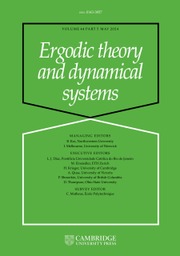Crossref Citations
This article has been cited by the following publications. This list is generated based on data provided by Crossref.
Bakhtin, Victor
2014.
The McMillan Theorem for Colored Branching Processes and Dimensions of Random Fractals.
Entropy,
Vol. 16,
Issue. 12,
p.
6624.
JÄRVENPÄÄ, ESA
JÄRVENPÄÄ, MAARIT
LI, BING
and
STENFLO, ÖRJAN
2016.
Random affine code tree fractals and Falconer–Sloan condition.
Ergodic Theory and Dynamical Systems,
Vol. 36,
Issue. 5,
p.
1516.
JÄRVENPÄÄ, ESA
JÄRVENPÄÄ, MAARIT
WU, MENG
and
WU, WEN
2017.
Random affine code tree fractals: Hausdorff and affinity dimensions and pressure.
Mathematical Proceedings of the Cambridge Philosophical Society,
Vol. 162,
Issue. 2,
p.
367.
Troscheit, Sascha
2020.
The quasi-Assouad dimension of stochastically self-similar sets.
Proceedings of the Royal Society of Edinburgh: Section A Mathematics,
Vol. 150,
Issue. 1,
p.
261.
Allaart, Pieter
and
Jones, Taylor
2023.
Box-counting dimension and differentiability of box-like statistically self-affine functions.
Journal of Mathematical Analysis and Applications,
Vol. 521,
Issue. 2,
p.
126909.
Feng, De-Jun
Lo, Chiu-Hong
and
Ma, Cai-Yun
2023.
Dimensions of projected sets and measures on typical self-affine sets.
Advances in Mathematics,
Vol. 431,
Issue. ,
p.
109237.
Feng, Zhou
2024.
Intermediate dimensions under self-affine codings.
Mathematische Zeitschrift,
Vol. 307,
Issue. 1,


